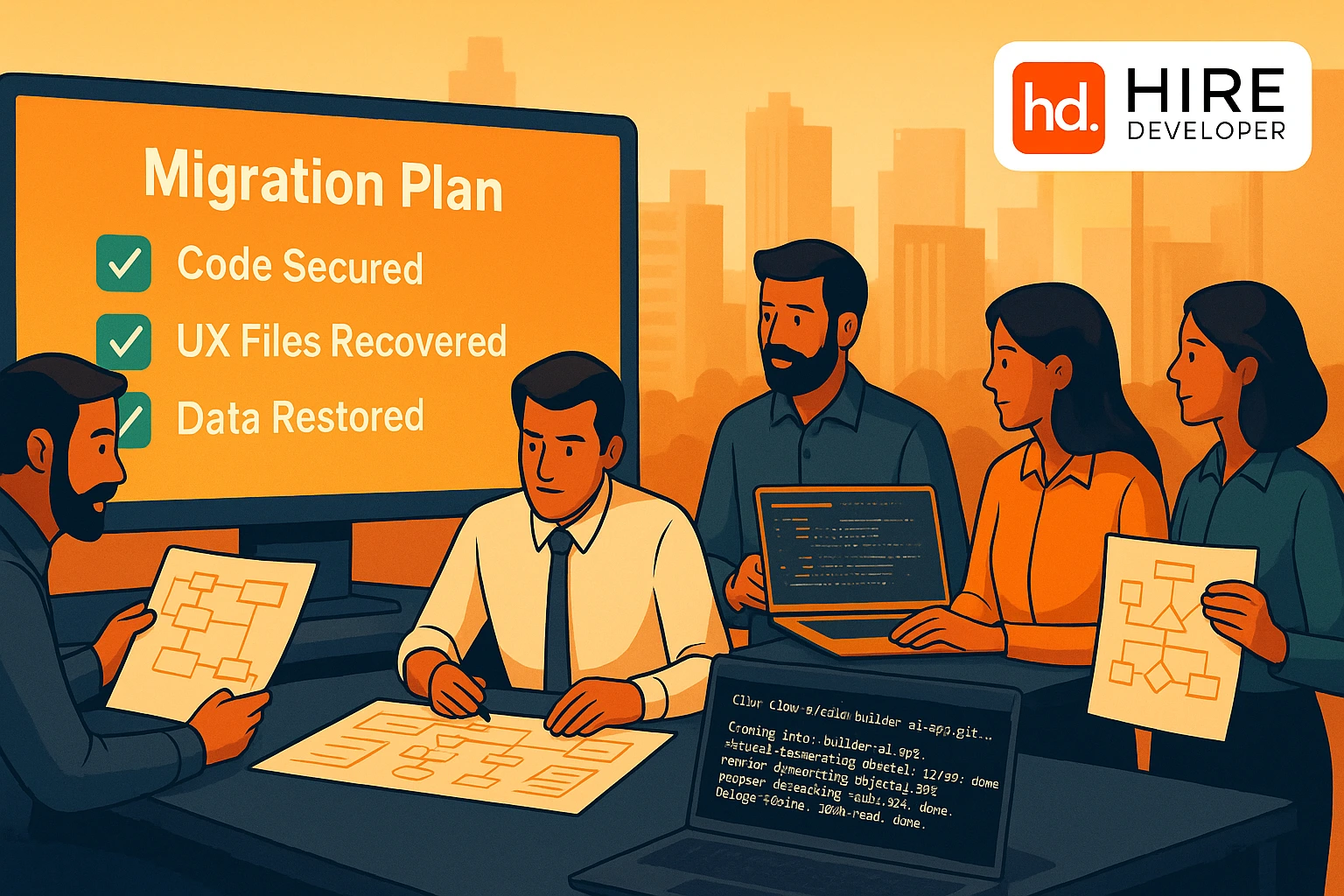“If Builder.ai powered your app, chances are you’re now stuck in a fog.”
No support. No code updates. Maybe no access at all.
The good news? You don’t have to start from scratch. You need a clear, founder-friendly, no-nonsense checklist to migrate your project before more time and trust are lost.
Step-by-Step Checklist to Migrate Your Project from Builder.ai
Step 1: Secure All Available Code and Assets
Before anything else, gather what you can:
- GitHub or Bitbucket repositories (if shared).
- App builds or .apk/.ipa files.
- UX/UI files (Figma, Sketch).
- API documentation.
- Admin panel credentials (if accessible).
Even a half-complete export can save weeks of rebuild time.
Tip: If you have team members or past devs who worked with Builder.ai, reach out; they might still have local versions.
Step 2: Create a Snapshot of Current Functionality
Use screen recordings, flow diagrams, or exports from your staging/live version to document:
- User journeys.
- Feature sets.
- Backend processes.
This becomes a reconstruction blueprint if you lose access entirely, and helps a new team estimate work faster.
Step 3: Evaluate the Stack and Its Portability
Builder.ai often used internalised frameworks. A migration expert can help:
- Translate the stack into mainstream tech (Node.js, React, etc.)
- Rebuild only the fragile parts, not everything.
This audit determines what’s reusable, refactorable, or redundant.
Step 4: Choose Your New Execution Model Wisely
This is where most startups trip again, jumping into another platform or agency with the same lock-in patterns.
Recommended path:
- Staff Augmentation – plug in vetted developers into your team.
- Transparent Billing – pay for output, not vague overhead.
- Direct Access – keep your Git, infra, and repos under your control.
HireDeveloper.Dev helps Builder.ai users rebuild while retaining IP, code access, and workflow visibility.
Step 5: Rebuild Critical Paths First
Don’t try to relaunch everything in one go. Focus first on:
- User login/auth.
- Dashboard core views.
- Payment or data features.
- Admin panel.
The goal is a viable relaunch, not a perfect replica.
Your new team can handle technical debt later; right now, you need to get back online.
Step 6: Communicate Transparently (with Everyone)
Inform stakeholders:
- You’ve identified the failure.
- You’ve secured core assets.
- You have a new partner/team.
- Timeline and scope adjustments are underway.
This restores trust, even if the product is still being patched.
Bonus: Things to Avoid During Migration
- Don’t hand over your project to another closed-box platform.
- Don’t delay decision-making, every day adds cost.
- Don’t settle for “we’ll see” from your next partner.
- Do demand Git access, DevOps transparency, and milestone-based updates.
Need help migrating from Builder.ai?
At HireDeveloper.Dev, we specialise in Builder.ai project migration services, helping startups and businesses seamlessly transition their apps and platforms while ensuring full code ownership, data integrity, and development control. Whether you’re facing limitations with scalability, code access, or team collaboration, our experts are ready to assist.
We’ve successfully recovered, rebuilt, and relaunched multiple projects for clients across various industries. Don’t let platform restrictions hold you back. Schedule a free consultation call with us today and discover how we can help you regain control and accelerate your product’s growth.
Related Resources:
- What Happened to Builder.ai? A Breakdown for Startup Founders
- How Builder.AI’s Collapse Shook the Startup World?
- How to React When Your Development Partner Fails Overnight?
- The 5 Stages of Vendor Grief and How to Get Unstuck
- Builder.ai’s Fall: Lessons for Product Owners and CTOs
- You Don’t Need to Start Over How to Transfer Your Project Safely
- From Panic to Progress, Real Strategies to Move on from Builder.ai
- Why Moving Fast Now After Builder.ai’s Collapse Will Save You Months Later
- How HireDeveloper.Dev Helps Builder.ai Clients Rebuild with Confidence
- Builder.ai vs. Human-Led Dev Teams: What We’ve Learned
- No More Black Boxes: The Power of Developer Transparency
- AI Was the Hype: Human Execution Is the Reality
- In Crisis, Founders Need More Than Just Tech: They Need Trust
- Why Owning Your Codebase Is Non-Negotiable in 2025
- Avoiding the Next Builder.ai: Red Flags Every Buyer Should Watch For
- From Locked to Liberated: How We Helped Former Builder.ai Clients Reclaim Control
- The Myth of One-Click Apps: Why Custom Always Wins in the Long Run
- What Every Investor Wants to Know: Technical Due Diligence After Builder.ai
- From Recovery to Resilience: A Blueprint for Building Post-Builder.ai

